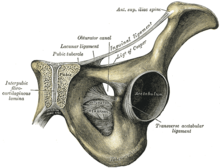Obturate foramen

The foramen obturatum ("blocked hole", also foramen obturatorium ) is a large opening in the bony pelvis . It is formed by the pubic bone and the ischium . The obturator foramen is largely closed by a firm connective tissue membrane ( obturator membrane ), the internal obturator muscle and the external obturator muscle . Only one opening for conduction pathways - the obturator canal - remains free, through which the obturator nerve and the obturator vein and artery pass.
In humans, the edge of the obturator foramen shows various protrusions, which are variable and therefore do not occur in every individual:
- The anterior obturator tubercle lies in the upper anterior part of the margin.
- The posterior obturator tubercle lies in the upper posterior part of the margin, but is occasionally absent and can only rarely be seen in the radiograph.
- Further protrusions: Individually more or less pronounced protrusions can also appear on the rest of the edge. It is a matter of dispute whether these are anatomical variations or reactions of the bone in the sense of an exostosis .
The obturator foramen is a weak point in the pelvic floor . Entrails can protrude through the canal and cause an obturator hernia . It mainly affects women over 70 years of age who have had multiple births. The obturator hernia is often combined with a femoral hernia .
literature
- Mark Buchta: The Physikum: Compendium for the 1st section of the medical examination . 2nd Edition. Urban & Fischer, 2009, ISBN 978-3-437-43051-0 , pp. 70 .
- Rudolf Birkner: The typical X-ray image of the skeleton: standard findings and varieties from adults and children . Urban & Fischer, 2009, ISBN 978-3-437-21222-2 , pp. 218 .
- ↑ Volker Schumpelick: Hernias . Georg Thieme, Stuttgart 2000, ISBN 978-3-13-117364-5 , p. 332.